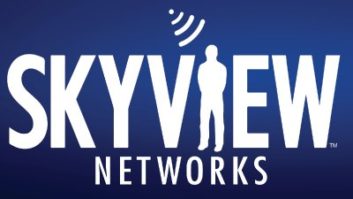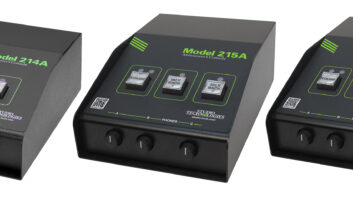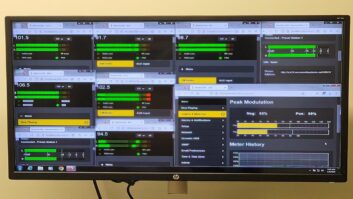Clear Channel Chicago Upgrades Audio Network
Apr 1, 2011 1:00 AM, By Bob Fukuda
Multiple studios receive an audio network upgrade

The Pivot Room is an auxiliary studio, but it’s outfitted the same as the main seven studios.
Clear Channel Chicago operates seven stations in the nation’s third largest market, consolidating five FMs and two AMs into a single facility. The facility is nearing the conclusion of a studio integration project that radically upgrades the networked audio system, minimizing infrastructure and simplifying the workflow.
The consolidated operation comprises two floors of a large building at 233 N. Michigan Ave. in the Loop neighborhood of downtown Chicago. On-air and production resides on the 27th floor, with the sales and business operation located one floor above. Each floor encompasses 37,500 square feet.

WKSC main production has a layout similar to the other production studios.
The root of the upgrade involves a transition from a serviceable but outdated networked audio system to a Harris VistaMax platform. At press time, 21 of the 28 studios have migrated to the new system, with the final rooms on schedule for an early spring transition.
The original layout of the facility was designed in the tradition of pods, with localized studio clusters representing each station. Depending on the operation, each station has three or four studios per cluster — one on-air control room and a mix of production and voice track studios to suit the operation. The facility also has two independent on-air studios and one multi-purpose studio on the 27th floor, and a performance space/studio on the 28th floor. Every studio ties to the VistaMax network.

Voice Track Studio 4 has a Vistamax console at its center.
On the main floor, urban stations WGCI-FM, WVAZ-FM and WGRB-AM are located in the north hall, with the remaining four stations (WKSC-FM, WLIT-FM, WNUA-FM and LMA station WVON-AM) situated in the south hall. A large technical operations center (TOC) separates the two halls, housing all of the racks and infrastructure equipment that powers the studio operation.
Technical core
The motivating influence behind the rebuild was based on problems with the existing networked audio system. Issues with spare parts and technical support aside, the architecture made little sense in the modern studio environment. An audio frame was required in each studio, and every component pertinent to the local operation was wired to that frame.
A dedicated server was required for each control surface, further expanding the footprint. Ultimately, the central electronics absorbed five full equipment racks in the TOC — an enormous amount of real estate by today’s standards. The VistaMax system, even with additional headroom, reduces the footprint to a single rack, clearing four racks for other purposes. One has since been repopulated with new equipment, but the total infrastructure has been reduced from 77 to 74 racks.
A newly constructed wall in the TOC centralizes the wiring blocks for VistaMax. Audio systems are wired to Krone blocks, with optos and relays wired to standard Telco 66 punch blocks. Harnesses built into the VistaMax frame support direct wiring from the blocks, eliminating the X21 connectors required for the previous system.
Existing multimode fiber to each studio was replaced with 25-pair CAT-5 wiring. The re-use of existing analog trunks for redundant signal transport ensures there is no single point of failure from TOC to the studios.
The general on-air signal flow begins with the RCS NexGen system; the system’s audio server sends the program audio to the Krone blocks and into VistaMax. From there, the signals move on to the processing racks, filled with Omnia-6eXi (FM) and Omnia-5eXi (AM) units for analog and HD Radio signal processing. Harris Intraplex STL HD provide audio transport over T1 links to multiple transmission points around the city, including the John Hancock Center and the Willis Tower among other sites.
— continued on page 2
Clear Channel Chicago Upgrades Audio Network
Apr 1, 2011 1:00 AM, By Bob Fukuda
Post-delay audio for online streams breaks off prior to hitting the Intraplex units. Online streams for all HD Radio and FM/AM signals are supported and delivered by Akamai Networks.
A bulk of the remaining TOC equipment is dedicated to signal monitoring. On-staff engineering in Chicago developed an Intelligent Silence Sensor to monitor each station. The system also monitors Arbitron Portable People Meters (PPM) for all program streams, including HD2 channels and online properties.

The auxiliary production studio is temporarily being used as WVAZ’s production room until the finishing touches are complete on the WVAZ large production room.
Elsewhere in TOC, XDS satellite receivers for Citadel Broadcasting and Premiere Radio Networks bring in syndicated programming from Doug Banks and The Steve Harvey Show, respectively. Sage Endec units are also located in the TOC to automatically trigger EAS signals for each station.
The HVAC system is designed to keep all the equipment in top operating conditioning, with three-ton and three five-ton condenser units providing forced air over powered cooling water. Three APC 40kVA UPS units provide backup to the entire system, able to support the entire operation for approximately 50 minutes. The units are only required to support the studios for a little more than 90 seconds, as Clear Channel Chicago shares a large generator with the building system.
On-air and production
The on-air operation consists of nine 12×18 studios — one for each station and two specialty studios. All are built to similar specifications, with Harris PR&E custom furniture and turret assemblies housing all the required equipment. Harris PR&E RMXdigital consoles connect to the central VistaMax system, with jocks able to pull up sources from any of the console channels.
Other sources wired to each on-air console include five microphone processors (Symetrix 528A or AirTools 6200 units, wired mono to the five left channels), Telos 2101 phone hybrid signals, NexGen automation, Audion Labs VoxPro record/edit systems, Tascam CD players and Harris World Feed Panels. The World Feed Panel is a multi-user interface panel that provides a host of inputs and outputs for guests (musicians, TV production crews). This provides a direct-to-air interface for external source equipment.
RMXdigital is a clear upgrade from the previous on-air console. One notable improvement is mix-minus. The older consoles offered one mix-minus channel, which made live channel mixing a cumbersome process. The RMXdigital provides six distinct mix-minus channels for our jocks, providing far more on-air flexibility.

Voice track studio 2 is also used by WLIT for AM drive.
The furniture is mostly designed for stand-up shows, with one host and four guest positions. Five Electro-Voice RE-27 or RE-20 microphones hang over the guest/host positions in most of the studios, with Harris 3×6 headphone distribution amplifiers built into the furniture. CDAir W2000 CD burners are also installed in the turrets atop the furniture surfaces for talent air checks.
Production studios are similarly outfitted, though vary in size and console choice. Four 12×18 large production rooms feature RMXdigital consoles, while six smaller 12×10 production rooms feature Harris PR&E NetWave digital consoles. The NetWave delivers audio networking to the smaller production rooms via custom dual-fader modules on three channels to support routable sources. All production studios also add Adobe Audition and ProTools editing.
Music playlists for NexGen automation are built mostly on computers in the production studios. On the 28th floor, the traffic and billing operation ingests commercials, promos and other interstitials into the system. The NexGen server in the TOC automatically makes sense of the various elements coming from two different operations.
— continued on page 3
Clear Channel Chicago Upgrades Audio Network
Apr 1, 2011 1:00 AM, By Bob Fukuda
Specialty studios
Voice track studios add an important element to the station programming. These smaller studios have a limited amount of equipment, with Harris PR&E StereoMixer digital consoles providing seven linear faders, four analog inputs, three digital inputs and mix-minus capabilities.

The rack room houses the Vistamax routing frames.
Adobe Audition provides editing capability. Computers were added to the rack room and converted to Audition machines, with the program wired to the second channel on each StereoMixer. Three channels of NexGen automation and a microphone processor serve as additional StereoMixer sources. In all, these consoles offer three more channels than the previous voice tracking consoles.
The two additional on-air studios provide homes for certain shows. “Brotha Fred’s Morning Mayhem”, heard locally on WKSC, broadcasts from one of these studios. The layout is slightly different from the other on-air control rooms, with an additional microphone and guest seat added to the sit-down furniture design.
The final on-air control room, dubbed “The Pivot Room,” serves as an auxiliary/backup studio, outfitted the same as the main seven. The Reverend Jesse Jackson exclusively uses this studio for his Sunday morning “Keep Hope Alive” program heard locally on WVON. Similarly, any of the fully equipped productions studios can quickly be converted to on-air studios if necessary.

Neat and orderly wiring: the wall of punchblocks behind the racks.
The most unique studio is the “Beat Mix Studio,” essentially an unused talk studio where jocks can add live mixes to the on-air programs. This studio features VistaMax network sources, six microphones and an Odyssey Battle Coffin for live mixes. The Battle Coffin includes two turntables in battle position, one mixer and a laptop. This studio also occasionally hosts live musical guests and other specialty programs, including a recent political candidate debate.
Upstairs, the 20×15 Coca-Cola Lounge features a 6×9 stage for scaled-down musical performances and artist meet-and-greets. The converted storage area is a carpeted studio outfitted with VistaMax sources and a Battle Coffin. The Battle Coffin units are popular here, as the urban stations all do live on-air mixing to some extent. WGCI broadcasts three live mixes per day: morning drive, Mix at 5 and Mix at 8.
Communication is key
The north hall wing, home of the urban format stations, features three pods of four studios each, while the south wing features four pods of four. Soundsoak acoustical wall panels and IEC-specified doors and windows provide acoustical treatments and noise-proofing as necessary.
Rather than rely solely on visual cueing through the glass windows, Harris added intercom functionality to the VistaMax systems. Personalities can now speak to each other via a simple pushbutton system — an important feature that the previous networking system lacked.
Harris also sent representatives to the facility to make the audio and logic wiring connections as part of its studio design services. This included the layout, harnessing and integration of wiring into the furniture design. We watched as Paul Barzizza, business development manager for Harris, crawled around the floor making all the necessary connections. Once arranged, we simply plugged everything in.
Simple connectivity is the central theme to this project. From the main VistaMax frame wiring in the TOC to the simple I/O connections at the networked consoles, onto the sensible studio furniture harnesses, the entire project showcased a clean migration from an antiquated methodology to a modernized networked audio system.
Equipment list
Adobe Audition
AirTools 6200
APC 40kVA UPS
Audion Labs VoxPro
Avid ProTools
Electro-Voice RE-20, RE-27
Harris Intraplex STL HD, PR&E NetWave, PR&E RMXdigital, PR&E StereoMixer, VistaMax, World Feed Panel
Odyssey FZBM10W Universal Fit
Battle Mix DJ Coffin
Omnia-5eXi, 6eXi
RCS NexGen
Sage Digital Endec
Symetrix 528A
Tascam CD players
Telos 2101
Fukuda is market director of engineering, Clear Channel Chicago. Photos by John Boehm.
April 2011
HD Radio monitors ,choosing an audio over IP network switch, a look at the Clear Channel Chicago rebuild, transmission line pressure monitoring, and Field Reports on the FM Services TLM-1 and Audio-Technica AT4040….
Facility Design
RADIO magazine covers facility design, radio design, recording studio design and production studio design for engineers, managers and owners….












